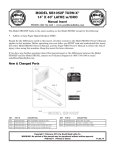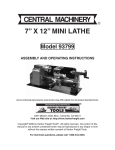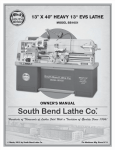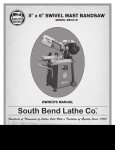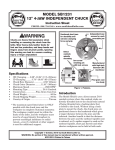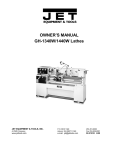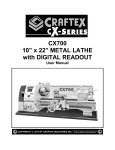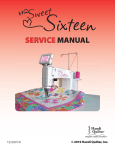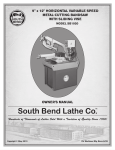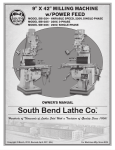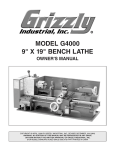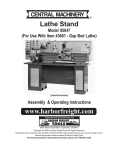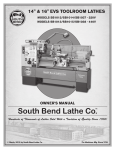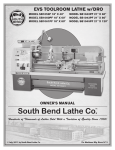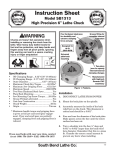Download Southbend sb1039 User's Manual
Transcript
14" TURN-X® TOOLROOM LATHE MODEL SB1039 14" X 40" MODEL SB1052 14" X 30" OWNER'S MANUAL © November, 2011 by South Bend Lathe Co. For Machines Mfg. Since 5/11 Scope of Manual This manual helps the reader understand the machine, how to prepare it for operation, how to control it during operation, and how to keep it in good working condition. We assume the reader has a basic understanding of how to operate this type of machine, but that the reader is not familiar with the controls and adjustments of this specific model. As with all machinery of this nature, learning the nuances of operation is a process that happens through training and experience. If you are not an experienced operator of this type of machinery, read through this entire manual, then learn more from an experienced operator, schooling, or research before attempting operations. Following this advice will help you avoid serious personal injury and get the best results from your work. Manual Feedback We've made every effort to be accurate when documenting this machine. However, errors sometimes happen or the machine design changes after the documentation process—so the manual may not exactly match your machine. If a difference between the manual and machine leaves you in doubt, contact our customer service for clarification. We highly value customer feedback on our manuals. If you have a moment, please share your experience using this manual. What did you like about it? Is there anything you would change to make it better? Did it meet your expectations for clarity, professionalism, and ease-of-use? South Bend Lathe, Inc. C /O Technical Documentation Manager P.O. Box 2027 Bellingham, WA 98227 Email: [email protected] Updates For your convenience, any updates to this manual will be available to download free of charge through our website at: www.southbendlathe.com Customer Service We stand behind our machines. If you have any service questions, parts requests or general questions about your purchase, feel free to contact us. South Bend Lathe Co. P.O. Box 2027 Bellingham, WA 98227 Phone: (360) 734-1540 Fax: (360) 676-1075 (International) Fax: (360) 734-1639 (USA Only) Email: [email protected] Table of Contents INTRODUCTION.....................................................3 About This Machine.............................................. 3 Foreword. ............................................................ 3 Capabilities.......................................................... 3 Features. ............................................................. 3 General Identification........................................... 4 Controls & Components....................................... 5 Master Power Switch............................................ 5 Two-Speed Motor Switch...................................... 5 Headstock............................................................ 5 Control Panel....................................................... 6 Carriage............................................................... 6 Tailstock.............................................................. 7 End Gears............................................................ 7 Safety Foot Brake................................................. 7 SAFETY.................................................................12 Understanding Risks of Machinery................... 12 Basic Machine Safety......................................... 12 Additional Metal Lathe Safety........................... 14 Additional Chuck Safety.................................... 15 PREPARATION.....................................................16 Preparation Overview......................................... 16 Things You'll Need.............................................. 16 Power Supply Requirements.............................. 17 Availability........................................................ 17 Full-Load Current Rating................................... 17 Circuit Requirements......................................... 17 Grounding Requirements. .................................. 18 Extension Cords................................................. 18 Unpacking........................................................... 19 Inventory............................................................. 19 Cleaning & Protecting........................................ 20 Physical Environment........................................ 21 Electrical Installation......................................... 21 Lighting............................................................. 21 Weight Load....................................................... 21 Space Allocation................................................. 21 Lifting & Moving................................................. 22 Leveling & Mounting.......................................... 23 Leveling............................................................. 23 Bolting to Concrete Floors. ................................. 24 Assembly............................................................. 24 Lubricating Lathe............................................... 24 Adding Coolant................................................... 25 Power Connection............................................... 25 Test Run.............................................................. 26 Spindle Break-In................................................. 30 Recommended Adjustments............................... 30 OPERATION.........................................................31 Operation Overview............................................ 31 Chuck & Faceplate Mounting............................ 32 Installation & Removal Devices......................... 32 Chuck Installation.............................................. 33 Registration Marks. ........................................... 34 Chuck Removal................................................... 34 Scroll Chuck Clamping....................................... 35 4-Jaw Chuck........................................................ 35 Mounting Workpiece. ......................................... 35 Faceplate............................................................. 36 Tailstock.............................................................. 37 Positioning Tailstock.......................................... 37 Using Quill. ....................................................... 37 Installing Tooling............................................... 38 Removing Tooling............................................... 39 Offsetting Tailstock............................................ 39 Aligning Tailstock to Spindle Centerline............. 40 Centers................................................................ 41 Dead Centers. .................................................... 41 Live Centers....................................................... 42 Mounting Dead Center in Spindle....................... 42 Removing Center from Spindle........................... 42 Mounting Center in Tailstock............................. 42 Removing Center from Tailstock......................... 43 Mounting Workpiece Between Centers................ 43 Steady Rest......................................................... 44 Follow Rest.......................................................... 45 Carriage & Slide Locks....................................... 45 Compound Rest................................................... 46 Four-Way Tool Post............................................ 46 Installing Tool.................................................... 46 Aligning Cutting Tool with Spindle Centerline.... 47 Adjustable Feed Stop.......................................... 48 Micrometer Stop................................................. 48 Manual Feed....................................................... 49 Carriage Handwheel. ......................................... 49 Cross Slide Handwheel....................................... 49 Compound Rest Handwheel................................ 49 Spindle Speed...................................................... 49 Determining Spindle Speed................................ 49 Setting Spindle Speed. ....................................... 50 Configuration Examples..................................... 50 Power Feed.......................................................... 51 Power Feed Controls. ......................................... 52 Setting Power Feed Rate. ................................... 53 End Gears............................................................ 54 Standard End Gear Configuration. ..................... 54 Alternate Configuration...................................... 55 Threading............................................................ 56 Headstock Threading Controls............................ 56 Apron Threading Controls.................................. 57 Thread Dial........................................................ 57 Thread Dial Chart.............................................. 58 Chip Drawer........................................................ 59 Coolant System................................................... 60 ACCESSORIES....................................................61 MAINTENANCE....................................................64 Maintenance Schedule........................................ 64 Cleaning & Protecting........................................ 64 Maintenance Chart. ........................................... 65 Lubrication.......................................................... 66 Headstock.......................................................... 66 Quick-Change Gearbox....................................... 67 Apron................................................................. 67 One-Shot Oiler................................................... 68 Longitudinal Leadscrew. .................................... 68 Ball Oilers & Oil Cup. ........................................ 69 End Gears.......................................................... 70 Coolant System Service...................................... 71 Hazards............................................................. 71 Adding Fluid...................................................... 72 Changing Coolant............................................... 72 Machine Storage................................................. 73 SERVICE...............................................................74 Backlash Adjustment......................................... 74 Compound Rest.................................................. 74 Cross Slide......................................................... 74 Leadscrew End Play Adjustment....................... 75 Gib Adjustment................................................... 75 Half Nut Adjustment.......................................... 77 V-Belts................................................................. 77 Brake & Switch................................................... 78 Leadscrew Shear Pin Replacement................... 80 Gap Insert Removal & Installation................... 82 Gap Removal...................................................... 82 Gap Installation................................................. 83 TROUBLESHOOTING..........................................84 ELECTRICAL.........................................................87 Electrical Safety Instructions............................ 87 Correcting Phase Polarity Wiring...................... 88 Wiring Overview................................................. 88 Component Location Index................................ 89 Electrical Cabinet Wiring................................... 90 Electrical Box...................................................... 91 Spindle Motor...................................................... 92 Cutting Fluid Pump Wiring............................... 92 2-Speed Motor Switch......................................... 93 Control Panel Wiring.......................................... 94 Spindle Switches................................................. 94 Additional Component Wiring........................... 95 Power Connection............................................... 95 PARTS...................................................................96 Headstock Cover................................................. 96 Headstock Controls............................................. 97 Headstock Internal Gears.................................. 99 Headstock Transfer Gears................................ 101 Gearbox Gears................................................... 102 Gearbox Controls.............................................. 104 Apron Front View............................................. 106 Apron Rear View............................................... 108 Compound Rest & Tool Post............................. 110 Saddle Top View............................................... 111 Saddle Bottom View......................................... 113 Bed Stop............................................................ 114 Dial Indicator.................................................... 114 Bed & Shafts..................................................... 115 End Gears.......................................................... 117 Main Motor........................................................ 118 Stands & Panels................................................ 120 Tailstock............................................................ 122 Steady Rest....................................................... 124 Follow Rest........................................................ 124 Electrical Cabinet & Control Panel................. 125 Accessories........................................................ 126 Front Machine Labels....................................... 127 Rear & Side Machine Labels............................ 128 Warranty........................................................129 For Machines Mfg. Since 5/11 INTRODUCTION 14" TURN-X® Toolroom Lathe About This Machine Foreword Features "The screw cutting engine lathe is the oldest and most important of machine tools and from it all other machine tools have been developed. It was the lathe that made possible the building of the steamboat, the locomotive, the electric motor, the automobile and all kinds of machinery used in industry. Without the lathe our great industrial progress of the last century would have been impossible." —How To Run a Lathe, 15th Edition, South Bend Lathe. These 16-Speed Gearhead Lathes are packed with standard features and equipment, such as a complete coolant system, easy-to-clean chip drawer, one-shot way lubrication system, included steady and follow rests, chuck guard, adjustable work lamp, foot brake, powered cross feed, 3- and 4-jaw chucks, faceplate, and premium Allen-Bradley contactors, thermal relays, and fuse system. The lathe represented in this manual is a modern day version of the screw cutting lathes that trace their roots back to the 1700's, which were themselves technological improvements of the bow lathe that can be traced back thousands of years to the ancient Egyptians. Now, almost 300 years later, these modern "screw cutting" lathes are not just a piece of refined machinery, but a culmination of human ingenuity and knowledge embodied into the design and synergy of thousands of interworking parts—some of which represent the life's work and dreams of many inventors, mechanical engineers, and world-class machinists—including the likes of Leonardo da Vinci, Henry Maudsley, and the founders of South Bend Lathe, John and Miles O'Brien. And now the torch is passed to you—to take the oldest and most important type of machine tool—and carry on the tradition. As the operator of a South Bend Lathe, you now join the ranks of some very famous and important customers, such as Henry Ford, who used the machines he purchased to help him change the world. Spindle speeds are controlled by convenient headstock levers, which allow the operator to quickly set the spindle speed within the available range of 50–2570 RPM. The beds of these lathes are constructed with Meehanite castings that are hardened and precision-ground in the traditional three V-way prismatic design—long used on South Bend Lathes for its accuracy, durability, and rigidity. The headstocks feature quick-change gear levers and the carriages include an adjustable clutch that disables automatic carriage feed when it contacts the included feed stop or in the event of a crash. To further ensure a high degree of accuracy, these lathes are equipped with Japanese spindle bearings. The spindles are D1-5 camlock with an MT#5 taper and 1.57" bore. The tailstocks have an MT#3 taper and 4.5" of quill travel. Capabilities This 16-Speed Toolroom Lathe is built for daily use in a busy industrial setting. Loaded with many nice features and high-precision parts, this lathe excels at making fine tools, dies, thread gauges, jigs, and precision test gauges—however, it is by no means delicate. Thick castings, heavy weight, and quality construction throughout provide the necessary brawn for demanding production and manufacturing tasks. South Bend Precision Toolroom Lathe (Circa 1958) -3- INTRODUCTION 14" TURN-X® Toolroom Lathe For Machines Mfg. Since 5/11 General Identification D B G F E H C I J K A U L T M N S R Q O P Figure 1. Identification. A. B. C. D. E. F. G. H. I. J. K. Headstock D1-5 Camlock MT#5 Spindle 3-Jaw Chuck 8" Chuck Guard w/Safety Switch Steady Rest Follow Rest Halogen Work Lamp 4-Way Tool Post Compound Rest Coolant Nozzle & Valve Tailstock (see Page 7 for details) Serious personal injury could occur if you connect the machine to power before completing the setup process. DO NOT connect power until instructed to do so later in this manual. -4- L. M. N. O. P. Q. R. S. T. U. Longitudinal Leadscrew Feed Rod Coolant Reservoir & Pump Access Carriage (see Page 6 for details) Safety Foot Brake Chip Drawer Micrometer Stop Two-Speed Motor Switch Quick-Change Gearbox Controls (see Page 5 for details) Headstock Controls (see Page 5 for details) Untrained users have an increased risk of seriously injuring themselves with this machine. Do not operate this machine until you have understood this entire manual and received proper training. For Machines Mfg. Since 5/11 INTRODUCTION Controls & Components Headstock A Refer to Figures 2–7 and the following descriptions to become familiar with the basic controls of this lathe. Master Power Switch 14" TURN-X® Toolroom Lathe E B F C The rotary switch shown in Figure 2 toggles incoming power ON and OFF to the lathe controls. It also prevents the electrical cabinet door from being opened when the switch is ON. D G Figure 4. Headstock controls. Main Power Switch Figure 2. Location of the master power switch. Two-Speed Motor Switch The two-speed motor switch has three positions: • • • Low (left position), enables speeds in the right headstock spindle speed chart OFF (middle position) High (right position), enables speeds in the left headstock spindle speed chart A. Spindle Speed Charts: Display the arrangement of the spindle range and spindle speed levers for each of the 16 spindle speeds. The two-speed motor switch selects the available speeds from the high or low spindle speed chart. B. Spindle Range Lever: Selects the speeds shown in the left (high) or right (low) spindle speed chart to be active. C. Spindle Speed Lever: Selects one of the four available spindle speeds within the selected speed range. D. Threading and Feed Charts: Displays the necessary configuration of the gearbox levers and end gears for different threading or feeding options. E. Gearbox Range Lever: Shifts the quickchange gearbox into low range, neutral, or high range. Two-Speed Motor Switch F. Headstock Feed Direction Lever: Controls the direction that the leadscrew and feed rod rotate. G. Quick-Change Gearbox Levers: Control the leadscrew and feed rod speed for threading and feed operations. Figure 3. Location of the two-speed motor switch. -5- INTRODUCTION 14" TURN-X® Toolroom Lathe Control Panel For Machines Mfg. Since 5/11 M. Compound Rest Handwheel: Moves the tool toward and away from the workpiece at the preset angle of the compound rest. N. Coolant Flow Control Lever: Controls the flow of coolant from the nozzle. I J O. One-Shot Oiler: Draws oil from the apron reservoir to lubricate the carriage ways through various oil ports. H P. Carriage Lock: Secures the carriage in place when it should not move. K H. Coolant Pump Switch: Controls the coolant pump motor. Q . Thread Dial and Chart: Dial indicates when to engage the half nut during threading operations. Chart indicates on which thread dial reading to engage the half nut for specific inch thread pitches. I. Power Light: Illuminates when lathe controls are receiving power. R. Spindle Lever: Starts, stops and reverses direction of spindle rotation. J. STOP Button: Stops all machine functions. Twist clockwise to reset. S . Half Nut Lever: Engages/disengages the half nut for threading operations. K. Jog Button: Starts forward spindle rotation as long as it is pressed. T. Apron Feed Direction Knob: Changes direction of the carriage or the cross slide feed without having to stop the lathe and move the headstock feed direction lever. Figure 5. Control panel. Carriage L U. Feed Selection Lever: Selects the carriage or cross slide for power feed. N M O V. Carriage Handwheel: Moves the carriage along the bed. P X W. Apron: Houses the carriage gearing. W V Q U T S X. Cross Slide Handwheel: Moves the cross slide toward and away from the workpiece. R Figure 6. Carriage controls. L. 4-Way Tool Post: Mounts up to four cutting tools at once that can be individually indexed to the workpiece. -6- For Machines Mfg. Since 5/11 INTRODUCTION Tailstock End Gears Z Y 14" TURN-X® Toolroom Lathe AB AA Configuring the end gears shown in Figure 8 will control the speed of the leadscrew for threading or the feed rod for power feed operations. The rotational speed of these components depends not only on the end gear configuration, but the spindle speed as well. AC AD AF AE Figure 7. Tailstock controls. Y. Quill Handwheel: Moves the quill toward or away from the spindle. Z. Graduated Scale: Indicates quill movement in increments of 0.001" with one full revolution equaling 0.200" of quill travel. AA.Tailstock Lock Lever: Secures the tailstock in position along the bedway. AB.Quill Lock Lever: Secures the quill in position. AC. Quill: Moves toward and away from the spindle and holds centers and tooling. AD.Tailstock Offset Screw: Adjusts the tailstock offset left or right from the spindle centerline (1 of 2). End Gears Figure 8. End gear components. Safety Foot Brake This lathe is equipped with a foot brake (see Figure 9) to quickly stop the spindle instead of allowing the spindle to coast to a stop on its own. Pushing the foot brake while the spindle is ON cuts power to the motor and stops the spindle. After the foot brake is used, the spindle lever must be returned to the OFF (middle) position to reset the spindle switches before re-starting spindle rotation. Spindle Lever AE. Gib Adjustment Screw: Adjusts the tapered gib to control tailstock offset accuracy (1 of 2). AF. Offset Scale: Indicates the relative distance of tailstock offset from the spindle centerline. Foot Brake Figure 9. Foot brake and spindle lever. -7- 14" TURN-X® Toolroom Lathe INTRODUCTION For Machines Mfg. Since 5/11 Product Specifications P.O. Box 2027, Bellingham, WA 98227 U.S.A. PHONE: (360) 734-1540 • © South Bend Lathe Co. www.southbendlathe.com MODEL SB1039 & SB1052 14" 16-SPEED TOOLROOM LATHES Model Number SB1039 SB1052 2420 lbs. 2094 lbs. Width (side-to-side)/Depth (front-to-back)/Height 80 3⁄4" X 32 1⁄8" X 54 3⁄8" 70" X 32 1⁄8" X 54 3⁄8" Foot Print (Width/Depth) 80 3⁄4" X 19 1⁄2" 70" X 19 1⁄2" Product Dimensions Weight Shipping Dimensions Type Weight Width (side-to-side)/Depth (front-to-back)/Height Wood Slat Crate 2684 lbs. 2314 lbs. 90" x 45" x 69" 79" x 45" x 69" Electrical Power Requirement Full-Load Current Rating Minimum Circuit Size Switch 220V, 3-Phase, 60Hz 14.4A 20A Magnetic with Thermal Protection Switch Voltage 220V Plug Included No Recommended Plug/Outlet Type -8- NEMA 15-20 For Machines Mfg. Since 5/11 Model Number INTRODUCTION 14" TURN-X® Toolroom Lathe SB1039 SB1052 Main Motor Type Horsepower TEFC Induction 5 HP at 3450 RPM, 2.5 HP at 1725 RPM Voltage 220V Phase 3-Phase Amps 14A at 3450 RPM, 10A at 1725 RPM Speed 3450/1725 RPM Cycle 60 Hz Power Transfer V-Belt & Gear Bearings Shielded & Permanently Sealed Coolant Motor Type TEFC Induction ⁄8 HP Horsepower 1 Voltage 220V Phase 3-Phase Amps 0.4A Speed 3450 RPM Cycle 60 Hz Power Transfer Bearings Direct Drive Shielded & Permanently Sealed Shielded & Permanently Sealed Operation Information Swing Over Bed Distance Between Centers 14.17" 40" 30" Swing Over Cross Slide 8.66" Swing Over Saddle 13.75" Swing Over Gap Maximum Tool Bit Size Compound Travel Carriage Travel Cross Slide Travel 20.94" N/A 0.75" 4" 36.5" 7" -9- 14" TURN-X® Toolroom Lathe Model Number INTRODUCTION For Machines Mfg. Since 5/11 SB1039 SB1052 Headstock Information Spindle Bore 1.653" Spindle Taper MT#5 Number of Spindle Speeds 16 Range of Spindle Speeds 50–2570 RPM Spindle Type D1-5 Camlock Spindle Bearings Tapered Roller Tailstock Information Tailstock Quill Travel 4 3⁄8" Tailstock Taper MT#3 Tailstock Barrel Diameter 1.968" Threading Information Number of Longitudinal Feeds 17 Range of Longitudinal Feeds 0.002"–0.067" Number of Cross Feeds 17 Range of Cross Feeds 0.001"–0.034" Number of Inch Threads 45 Range of Inch Threads 2–72 TPI Number of Metric Threads 39 Range of Metric Threads 0.20–14 mm Number of Modular Pitches 18 Range of Modular Pitches 0.3–3.5 MP Number of Diametral Pitches 21 Range of Diametral Pitches 8–44 DP Dimensions Bed Width 9" 1 1⁄8" Leadscrew Diameter Leadscrew TPI Leadscrew Length Steady Rest Capacity Follow Rest Capacity 4 TPI 59" 47" ⁄16"–4 ⁄16" 5 5 ⁄8"–3 1⁄8" 5 Faceplate Size 12" Feed Rod Diameter 3 ⁄4" Floor to Center Height 42 5⁄8" Height With Leveling Jacks 54 3⁄8" -10- For Machines Mfg. Since 5/11 Model Number INTRODUCTION 14" TURN-X® Toolroom Lathe SB1039 SB1052 Construction Headstock Headstock Gears Bed Cast Iron Flame-Hardened Steel Meehanite Castings with Precision Hardened-and-Ground Ways Stand Cast Iron Paint Urethane Other Country of Origin Warranty Serial Number Location Assembly Time Sound Rating at Idle Taiwan (Some Components Made in USA & Japan) 1 Year ID Label on Front of Headstock Approximately 1 Hour 76 dB -11- 14" TURN-X® Toolroom Lathe SAFETY For Machines Mfg. Since 5/11 Understanding Risks of Machinery Operating all machinery and machining equipment can be dangerous or relatively safe depending on how it is installed and maintained, and the operator's experience, common sense, risk awareness, working conditions, and use of personal protective equipment (safety glasses, respirators, etc.). The owner of this machinery or equipment is ultimately responsible for its safe use. This responsibility includes proper installation in a safe environment, personnel training and usage authorization, regular inspection and maintenance, manual availability and comprehension, application of safety devices, integrity of cutting tools or accessories, and the usage of approved personal protective equipment by all operators and bystanders. The manufacturer of this machinery or equipment will not be held liable for injury or property damage from negligence, improper training, machine modifications, or misuse. Failure to read, understand, and follow the manual and safety labels may result in serious personal injury, including amputation, broken bones, electrocution, or death. The signals used in this manual to identify hazard levels are as follows: Death or catastrophic harm WILL occur. Death or catastrophic harm COULD occur. Moderate injury or fire MAY occur. Machine or property damage may occur. Basic Machine Safety Owner’s Manual: All machinery and machining equipment presents serious injury hazards to untrained users. To reduce the risk of injury, anyone who uses THIS item MUST read and understand this entire manual before starting. Personal Protective Equipment: Operating or servicing this item may expose the user to flying debris, dust, smoke, dangerous chemicals, or loud noises. These hazards can result in eye injury, blindness, longterm respiratory damage, poisoning, cancer, reproductive harm or hearing loss. Reduce your risks from these hazards by wearing approved eye protection, respirator, gloves, or hearing protection. -12- Trained/Supervised Operators Only: Untrained users can seriously injure themselves or bystanders. Only allow trained and properly supervised personnel to operate this item. Make sure safe operation instructions are clearly understood. If electrically powered, use padlocks and master switches, and remove start switch keys to prevent unauthorized use or accidental starting. Guards/Covers: Accidental contact with moving parts during operation may cause severe entanglement, impact, cutting, or crushing injuries. Reduce this risk by keeping any included guards/covers/doors installed, fully functional, and positioned for maximum protection. For Machines Mfg. Since 5/11 SAFETY 14" TURN-X® Toolroom Lathe Entanglement: Loose clothing, gloves, neckties, jewelry or long hair may get caught in moving parts, causing entanglement, amputation, crushing, or strangulation. Reduce this risk by removing/securing these items so they cannot contact moving parts. Chuck Keys or Adjusting Tools: Tools used to adjust spindles, chucks, or any moving/ rotating parts will become dangerous projectiles if left in place when the machine is started. Reduce this risk by developing the habit of always removing these tools immediately after using them. Mental Alertness: Operating this item with reduced mental alertness increases the risk of accidental injury. Do not let a temporary influence or distraction lead to a permanent disability! Never operate when under the influence of drugs/alcohol, when tired, or otherwise distracted. Work Area: Clutter and dark shadows increase the risks of accidental injury. Only operate this item in a clean, non-glaring, and welllighted work area. Safe Environment: Operating electrically powered equipment in a wet environment may result in electrocution; operating near highly flammable materials may result in a fire or explosion. Only operate this item in a dry location that is free from flammable materials. Electrical Connection: With electically powered equipment, improper connections to the power source may result in electrocution or fire. Always adhere to all electrical requirements and applicable codes when connecting to the power source. Have all work inspected by a qualified electrician to minimize risk. Properly Functioning Equipment: Poorly maintained, damaged, or malfunctioning equipment has higher risks of causing serious personal injury compared to those that are properly maintained. To reduce this risk, always maintain this item to the highest standards and promptly repair/service a damaged or malfunctioning component. Always follow the maintenance instructions included in this documentation. Unattended Operation: Electrically powered equipment that is left unattended while running cannot be controlled and is dangerous to bystanders. Always turn the power OFF before walking away. Disconnect Power: Adjusting or servicing electrically powered equipment while it is connected to the power source greatly increases the risk of injury from accidental startup. Always disconnect power BEFORE any service or adjustments, including changing blades or other tooling. Health Hazards: Certain cutting fluids and lubricants, or dust/smoke created when cutting, may contain chemicals known to the State of California to cause cancer, respiratory problems, birth defects, or other reproductive harm. Minimize exposure to these chemicals by wearing approved personal protective equipment and operating in a well ventilated area. Secure Workpiece/Tooling: Loose workpieces, cutting tools, or rotating spindles can become dangerous projectiles if not secured or if they hit another object during operation. Reduce the risk of this hazard by verifying that all fastening devices are properly secured and items attached to spindles have enough clearance to safely rotate. Difficult Operations: Attempting difficult operations with which you are unfamiliar increases the risk of injury. If you experience difficulties performing the intended operation, STOP! Seek an alternative method to accomplish the same task, ask a qualified expert how the operation should be performed, or contact our Technical Support for assistance. -13- 14" TURN-X® Toolroom Lathe SAFETY For Machines Mfg. Since 5/11 Additional Metal Lathe Safety Speed Rates. Operating the lathe at the wrong speed can cause nearby parts to break or the workpiece to come loose, which will result in dangerous projectiles that could cause severe impact injuries. Large or non-concentric workpieces must be turned at slow speeds. Always use the appropriate feed and speed rates. Chuck Key Safety. A chuck key left in the chuck can become a deadly projectile when the spindle is started. Always remove the chuck key after using it. Develop a habit of not taking your hand off of a chuck key unless it is away from the machine. Safe Clearances. Workpieces that crash into other components on the lathe may throw dangerous projectiles in all directions, leading to impact injury and damaged equipment. Before starting the spindle, make sure the workpiece has adequate clearance by hand-rotating it through its entire range of motion. Also, check the tool and tool post clearance, chuck clearance, and saddle clearance. Long Stock Safety. Long stock can whip violently if not properly supported, causing serious impact injury and damage to the lathe. Reduce this risk by supporting any stock that extends from the chuck/headstock more than three times its own diameter. Always turn long stock at slow speeds. Securing Workpiece. An improperly secured workpiece can fly off the lathe spindle with deadly force, which can result in a severe impact injury. Make sure the workpiece is properly secured in the chuck or faceplate before starting the lathe. Chucks. Chucks are very heavy and difficult to grasp, which can lead to crushed fingers or hands if mishandled. Get assistance when handling chucks to reduce this risk. Protect your hands and the precision-ground ways by using a chuck cradle or piece of plywood over the ways of the lathe when servicing chucks. Use lifting devices when necessary. -14- Clearing Chips. Metal chips can easily cut bare skin—even through a piece of cloth. Avoid clearing chips by hand or with a rag. Use a brush or vacuum to clear metal chips. Stopping Spindle by Hand. Stopping the spindle by putting your hand on the workpiece or chuck creates an extreme risk of entanglement, impact, crushing, friction, or cutting hazards. Never attempt to slow or stop the lathe spindle with your hand. Allow the spindle to come to a stop on its own or use the brake. Crashes. Aggressively driving the cutting tool or other lathe components into the chuck may cause an explosion of metal fragments, which can result in severe impact injuries and major damage to the lathe. Reduce this risk by releasing automatic feeds after use, not leaving lathe unattended, and checking clearances before starting the lathe. Make sure no part of the tool, tool holder, compound rest, cross slide, or carriage will contact the chuck during operation. Coolant Safety. Coolant is a very poisonous biohazard that can cause personal injury from skin contact alone. Incorrectly positioned coolant nozzles can splash on the operator or the floor, resulting in an exposure or slipping hazard. To decrease your risk, change coolant regularly and position the nozzle where it will not splash or end up on the floor. Tool Selection. Cutting with an incorrect or dull tool increases the risk of accidental injury due to the extra force required for the operation, which increases the risk of breaking or dislodging components that can cause small shards of metal to become dangerous projectiles. Always select the right cutter for the job and make sure it is sharp. A correct, sharp tool decreases strain and provides a better finish. For Machines Mfg. Since 5/11 SAFETY 14" TURN-X® Toolroom Lathe Additional Chuck Safety Entanglement. Entanglement with a rotating chuck can lead to death, amputation, broken bones, or other serious injury. Never attempt to slow or stop the lathe chuck by hand, and always roll up long sleeves, tie back long hair, and remove any jewelry or loose apparel BEFORE operating. Chuck Speed Rating. Excessive spindle speeds greatly increase the risk of the workpiece or chuck being thrown from the machine with deadly force. Never use spindle speeds faster than the chuck RPM rating or the safe limits of your workpiece. Using Correct Equipment. Many workpieces can only be safely turned in a lathe if additional support equipment, such as a tailstock or steady rest, is used. If the operation is too hazardous to be completed with the lathe or existing equipment, the operator must have enough experience to know when to use a different machine or find a safer way. Trained Operators Only. Using a chuck incorrectly can result in workpieces coming loose at high speeds and striking the operator or bystanders with deadly force. To reduce the risk of this hazard, read and understand this document and seek additional training from an experienced chuck user before using a chuck. Chuck Capacity. Avoid exceeding the capacity of the chuck by clamping an oversized workpiece. If the workpiece is too large to safely clamp with the chuck, use a faceplate or a larger chuck if possible. Otherwise, the workpiece could be thrown from the lathe during operation, resulting in serious impact injury or death. Clamping Force. Inadequate clamping force can lead to the workpiece being thrown from the chuck and striking the operator or bystanders. Maximum clamping force is achieved when the chuck is properly maintained and lubricated, all jaws are fully engaged with the workpiece, and the maximum chuck clamping diameter is not exceeded. Proper Maintenance. All chucks must be properly maintained and lubricated to achieve maximum clamping force and withstand the rigors of centrifugal force. To reduce the risk of a thrown workpiece, follow all maintenance intervals and instructions in this document. Disconnect Power. Serious entanglement or impact injuries could occur if the lathe is started while you are adjusting, servicing, or installing the chuck. Always disconnect the lathe from power before performing these procedures. -15- 14" TURN-X® Toolroom Lathe P R E PA R AT I O N For Machines Mfg. Since 5/11 Preparation Overview Things You'll Need The purpose of the preparation section is to help you prepare your machine for operation. The list below outlines this basic process. Specific steps for each of these points will be covered in detail later in this section. The typical preparation process is as follows: 1. Unpack the lathe and inventory the contents of the box/crate. 2. Clean the lathe and its components. 3. Identify an acceptable location for the lathe and move it to that location. 4. Level the lathe and either bolt it to the floor or place it on mounts. 5. Assemble the loose components and make any necessary adjustments or inspections to ensure the lathe is ready for operation. 6. Check/lubricate the lathe. 7. Connect the lathe to the power source. 8. Test run the lathe to make sure it functions properly. 9. Perform the spindle break-in procedure to prepare the lathe for operation. -16- To complete the preparation process, you will need the following items: For Lifting and Moving • A forklift or other power lifting device rated for at least 25% more than the shipping weight of the lathe (see Product Specifications beginning on Page 8) • Lifting straps, each rated for at least 25% more than the shipping weight of the lathe • Guide rods for steading the load when lifting • Two other people for assistance when moving machine • Hardwood blocks (see Page 22) For Power Connection • A power source that meets the minimum circuit requirements for this machine (review Power Supply Requirements on the next page for details) • An electrician or qualified service personnel to ensure a safe and code-compliant connection to the power source For Cleaning & Assembly • Cotton rags • Mineral spirits • Quality metal protectant oil • Safety glasses • Wrench or socket 21mm • Wrench or socket 19mm • Floor mounting hardware as needed • Precision level • Standard screwdriver #2 For Machines Mfg. Since 5/11 P R E PA R AT I O N Power Supply Requirements Availability Before installing the machine, consider the availability and proximity of the required power supply circuit. If an existing circuit does not meet the requirements for this machine, a new circuit must be installed. To minimize the risk of electrocution, fire, or equipment damage, installation work and electrical wiring must be done by an electrician or qualified service personnel in accordance with all applicable codes. Serious injury could occur if you connect the machine to power before completing the setup process. DO NOT connect to power until instructed later in this manual. Full-Load Current Rating The full-load current rating is the amperage a machine draws at 100% of the rated output power. On machines with multiple motors, this is the amperage drawn by the largest motor or sum of all motors and electrical devices that might operate at one time during normal operations. SB1039 Full-Load Rating................. 14.4 Amps SB1052 Full-Load Rating................. 14.4 Amps For your own safety and protection of property, consult an electrician if you are unsure about wiring practices or applicable electrical codes. 14" TURN-X® Toolroom Lathe The full-load current is not the maximum amount of amps that the machine will draw. If the machine is overloaded, it will draw additional amps beyond the full-load rating. If the machine is overloaded for a sufficient length of time, damage, overheating, or fire may result—especially if connected to an undersized circuit. To reduce the risk of these hazards, avoid overloading the machine during operation and make sure it is connected to a power supply circuit that meets the requirements in the following section. Circuit Requirements This machine is prewired to operate on a 220V power supply circuit that has a verified ground and meets the following requirements: Nominal Voltage................................ 220V/240V Cycle..............................................................60 Hz Phase........................................................ 3-Phase Circuit Rating....................................... 20 Amps Cord.........."S" Type, 4-Wire, 12 AWG, 300 VAC Plug/Receptacle............................. NEMA 15-20 A power supply circuit includes all electrical equipment between the main breaker box or fuse panel in your building and the incoming power connections inside the machine. This circuit must be safely sized to handle the full-load current that may be drawn from the machine for an extended period of time. (If this machine is connected to a circuit protected by fuses, use a time fuse marked D.) Note:delay The circuit requirements in this manual are for a dedicated circuit—where only one machine will be running at a time. If this machine will be connected to a shared circuit where multiple machines will be running at the same time, consult a qualified electrician to ensure the circuit is properly sized. -17- P R E PA R AT I O N 14" TURN-X® Toolroom Lathe For Machines Mfg. Since 5/11 Grounding Requirements Extension Cords This machine must be grounded! In the event of certain types of malfunctions or breakdowns, grounding provides a path of least resistance for electric current in order to reduce the risk of electric shock. We do not recommend using an extension cord with this machine. If you must use an extension cord, only use it if absolutely necessary and only on a temporary basis. Improper connection of the equipment-grounding wire can result in a risk of electric shock. The wire with green insulation (with or without yellow stripes) is the equipment-grounding wire. If repair or replacement of the power cord is necessary, do not connect the equipmentgrounding wire to a live (current carrying) terminal. Check with an electrician or qualified service personnel if you do not understand these grounding requirements, or if you are in doubt about whether the machine is properly grounded. If you ever notice that a cord is damaged or worn, disconnect it from power, and immediately replace it with a new one. The power cord and plug specified under Circuit Requirements section on the previous page has an equipment-grounding wire and a grounding prong. The plug must only be inserted into a matching receptacle (outlet) that is properly installed and grounded in accordance with all local codes and ordinances (see Figure 10). Grounded Outlet Box Grounding Pin Current Carrying Blades Figure 10. Typical NEMA 15-20 plug and receptacle. -18- Extension cords cause voltage drop, which may damage electrical components and shorten motor life. Voltage drop increases as the extension cord size gets longer and the gauge size get smaller (higher gauge numbers indicate smaller sizes). Any extension cord used with this machine must contain a ground wire, match the required plug and receptacle, and meet the following requirements: Minimum Gauge Size................................ 12 AWG Maximum Length (Shorter is Better)............ 50 ft. For Machines Mfg. Since 5/11 P R E PA R AT I O N 14" TURN-X® Toolroom Lathe Unpacking This item was carefully packaged to prevent damage during transport. If you discover any damage, please immediately call Customer Service at (360) 734-1540 for advice. You may need to file a freight claim, so save the containers and all packing materials for possible inspection by the carrier or its agent. B A D Inventory Main Inventory 1: (Figure 11) A. B. C. D. E. F. G. H. I. J. K. L. M. N. O. P. Q. R. S. T. U. V. Qty Figure 11. Main inventory. G H I K J N L Qty Tool Box........................................................... 1 Open End Wrench 22/24mm.......................... 1 Open End Wrench 14/17mm.......................... 1 Open End Wrench 10/12mm.......................... 1 Phillips Screwdriver #2.................................. 1 Standard Screwdriver #2................................ 1 Hex Wrench 8mm........................................... 1 Tapered Spindle Sleeve MT#5-#3.................. 1 Dead Center MT#3.......................................... 1 Carbide-Tipped Dead Center MT#3............... 1 Camlock Key D1-5.......................................... 1 Tool Post T-Wrench (Clamped on Tool Post).1 Hex Wrench Set 1.5-10mm............................. 1 Carriage Handwheel Handle.......................... 1 Cross Slide Handwheel Handle...................... 1 Cast Iron Leveling Pads................................. 6 Pre-Installed (Not Shown) • • E Steady Rest Assembly (Installed).................. 1 10" Faceplate w/D1-5 Camlock Stud Set....... 1 10" 4-Jaw Chuck w/Combo Jaws (SB1227)... 1 3-Jaw Chuck Key............................................ 1 4-Jaw Chuck Key............................................ 1 Follow Rest Assembly (Installed)................... 1 Tool Box Inventory: (Figure 12) C F O Q P M T U R V S Figure 12. Toolbox inventory. If you cannot find an item on this list, check the mounting location on the machine or the packaging materials. Sometimes parts are pre-installed for shipping, or they become hidden by packaging materials. Qty 8" 3-Jaw Chuck (SB1309)............................... 1 8 1⁄4" Back Plate D1-5 (SB1399)....................... 1 Note: Some inventory components may be shipped inside of the lathe electrical box. These items MUST be removed before connecting the lathe to the power source. -19- 14" TURN-X® Toolroom Lathe P R E PA R AT I O N For Machines Mfg. Since 5/11 Cleaning & Protecting The unpainted surfaces are coated at the factory with a heavy-duty rust preventative that prevents corrosion during shipment and storage. The benefit of this rust preventative is that it works very well. The downside is that it can be time-consuming to thoroughly remove. Be patient and do a careful job when cleaning and removing the rust preventative. The time you spend doing this will reward you with smooth-sliding parts and a better appreciation for the proper care of the unpainted surfaces. Although there are many ways to successfully remove the rust preventative, the following process works well in most situations. Avoid chlorine-based solvents, such as acetone or brake parts cleaner that may damage painted surfaces. Always follow the manufacturer’s instructions when using any type of cleaning product. Basic steps for removing rust preventative: 1. 2. Coatallsurfacesthathaverustpreventative with a liberal amount of your cleaner or degreaser and let them soak for a few minutes. 3. Before cleaning, gather the following: • • • Disposablerags Cleaner/degreaser (certain citrus-based degreasers work extremely well and they have non-toxic fumes) Safetyglasses&disposablegloves Note: Automotive degreasers, mineral spirits, or WD•40canbeusedtoremoverustpreventative. Before using these products, though, test them on an inconspicuous area of a painted surface to make sure they will not damage it. GA S Gasoline and petroleum products have low flash points and can explode or cause fire if used for cleaning. Avoid using these products to remove rust preventative. Many cleaning solvents are toxic if inhaled. Minimize your risk by only using these products in a well ventilated area. -20- Put on safety glasses and disposable gloves. Wipe off the surfaces. If your cleaner or degreaser is effective, the rust preventative will wipe off easily. Note: To clean off thick coats of rust preventative on flat surfaces, such as beds or tables, use aPLASTICpaintscrapertoscrapeoffthe majority of the coating before wiping it off withyourrag.(Donotuseametalscraperor it may scratch the surface.) 4. Repeat Steps 2–3 as necessary until clean, then coat all unpainted surfaces with a quality metal protectant or light oil to prevent rust. Remove the end gear cover and end gears, and use a stiff brush with mineral spirits to clean the rust preventative from the gears and shafts. DO NOT get any cleaner or rust preventative on the V-belts, as it could damage them or make them slip during operations. If the belts do become contaminated, replace them. P R E PA R AT I O N For Machines Mfg. Since 5/11 Location 14" TURN-X® Toolroom Lathe Weight Load Physical Environment The physical environment where your machine is operated is important for safe operation and longevity of parts. For best results, operate this machine in a dry environment that is free from excessive moisture, hazardous or flammable chemicals, airborne abrasives, or extreme conditions. Extreme conditions for this type of machinery are generally those where the ambient temperature is outside the range of 41°– 104°F; the relative humidity is outside the range of 20–95% (non-condensing); or the environment is subject to vibration, shocks, or bumps. Electrical Installation Place this machine near an existing power source that meets the minimum circuit requirements. Make sure all power cords are protected from traffic, material handling, moisture, chemicals, or other hazards. Leave access to disconnect the power source or engage a lockout/tagout device. Refer to the Machine Specifications for the weight of your machine. Make sure that the surface upon which the machine is placed will bear the weight of the machine, additional equipment that may be installed on the machine, and the heaviest workpiece that will be used. Additionally, consider the weight of the operator and any dynamic loading that may occur when operating the machine. Space Allocation Consider the largest size of workpiece that will be processed through this machine and provide enough space around the machine for adequate operator material handling or the installation of auxiliary equipment. With permanent installations, leave enough space around the machine to open or remove doors/covers as required by the maintenance and service described in this manual. Lighting Lighting around the machine must be adequate enough that operations can be performed safely. Shadows, glare, or strobe effects that may distract or impede the operator must be eliminated. Children or untrained people may be seriously injured by this machine. Install machine in an access restricted location. Wall Electrical Cabinet Min. 30" for Maintenance Keep Workpiece Loading Area Unobstructed (Drawing Not To Scale) 48" 32" Lathe 84" (SB1039) 74" (SB1052) Figure 13. Space required for full range of movement. -21- 14" TURN-X® Toolroom Lathe P R E PA R AT I O N Lifting & Moving For Machines Mfg. Since 5/11 5. Position hardwood blocks under each end of the bed as shown in Figure 14. This will keep the lifting straps away from the leadscrew, feed rod, and spindle rod to prevent bending them during lifting. (Loooking at Lifting Setup from Tailstock End) To Power Lifting Equipment Leadscrew Lifting Strap Feed Rod Control Rod This machine and its parts are heavy! Serious personal injury may occur if safe moving methods are not used. To reduce the risk of a lifting or dropping injury, ask others for help, and use power equipment and guide rods. Do not attempt to lift or move this lathe without using the proper lifting equipment (such as forklift or crane) or the necessary assistance from other people. Each piece of lifting equipment must be rated for at least 25% more than the shipping weight of your lathe to support dynamic loads that may be applied while lifting. Refer to Things You'll Need on Page 16 for details. Lathe Bed Hardwood Blocks and Planks Positioned as Required to Prevent Lifting Straps from Bending Leadscrew Figure 14. Lifting setup to keep straps from bending leadscrew or rods. Note: Fasten a center support between the hardwood blocks so that they will stay spread apart and in place when lifting (see the example in Figure 15). To lift and move the lathe: Center Support 1. Remove the shipping crate top and sides, then remove the small components from the shipping pallet. 2. Move the lathe to its prepared location while it is still attached to the shipping pallet. 3. Unbolt the lathe from the shipping pallet 4. To balance the load for lifting, move the tailstock and carriage to the extreme right end of the bedway, then lock them in place. Note: Before attempting to move the carriage, make sure the carriage lock is loose, the half nut is disengaged, and the power feed is disengaged (feed selection lever). -22- Hardwood Blocking Figure 15. Example of blocking center support. For Machines Mfg. Since 5/11 P R E PA R AT I O N 6. Attach the lifting straps to the power lifting equipment (see Figure 16 for an example). Use Blocks as Necessary to Space Straps Away from Control Rod, Feed Rod, and Leadscrew to Prevent Bending when the Lathe is Lifted Power Lifting Equipment Lifting Straps 14" TURN-X® Toolroom Lathe Leveling & Mounting You must level your machine and either use the included foot pads and leveling hardware or bolt and shim your lathe to the floor. Because mounting your lathe to the floor with permanent hardware is an optional step and floor materials may vary, floor mounting hardware is not included. Leveling Hardwood Blocking Hardwood Blocking Figure 16. Example of lathe setup for lifting. 7. At each end of the lathe, have assistants connect guide rods to safely keep the lathe from swaying or tipping during lifting. When lifting the lathe with straps, the load will be top heavy. Take extra care to keep the load balanced vertically and only lift the lathe far enough to remove the shipping pallet. 8. Raise the lathe a couple of inches and check the balance of the load. — If the load is not safely balanced, immediately lower the lathe and resolve the issue before attempting to lift it again. 9. Raise the lathe enough to clear the shipping pallet, carefully remove the pallet, then lower the lathe into position. For accurate turning results and to prevent warping the cast iron bed and ways, the lathe bedways MUST be leveled from side-to-side and from front-to-back on both ends. Re-check the bedways 24 hours after installation, two weeks after that, and then annually to make sure they remain level. Leveling machinery helps precision components, such as bedways, remain straight and flat during the lifespan of the machine. Components on a machine that is not level may slowly twist due to the dynamic loads placed on the machine during operation. For best results, use a precision level that is at least 12" long and sensitive enough to show a distinct movement when a 0.003" shim (approximately the thickness of one sheet of standard newspaper) is placed under one end of the level. See the figure below for an example of a high precision level. Figure 17. Example of a precision level. -23- P R E PA R AT I O N 14" TURN-X® Toolroom Lathe To level the machine, use a precision level to make sure the bedways are level from side-toside and from front-to-back. —If using the included leveling pads (see Figure 18), place them under the six leveling jack bolt locations, then adjust the bolts to level the lathe. For Machines Mfg. Since 5/11 Assembly With the exception of the handwheel handles, the lathe is shipped fully assembled. To install the handwheel handles, thread the large handle into the carriage handwheel and the small handle into the cross slide handwheel, as shown in Figure 20. Jack Bolts Handwheel Handles Pads Figure 18. Leveling pads and screws. —If using mounting hardware that does not allow for adjustment, level the lathe by placing metal shims between the lathe base and the floor before bolting it down. Bolting to Concrete Floors Lag screws and anchors, or anchor studs (below), are two popular methods for bolting machinery to a concrete floor. We suggest you research the many options and methods for mounting your machine and choose the best one for your specific application. Anchor Stud Figure 20. Handwheel handles installed. Lubricating Lathe GEARBOXES MUST BE FILLED WITH OIL! OIL MAY NOT BE SHIPPED WITH MACHINE! Refer to Lubrication Section for Correct Oil Type. Lag Screw and Anchor Figure 19. Common types of fasteners for bolting machinery to concrete floors. Most electrical codes require that machines connected to the power source by fixed conduit MUST be secured to the floor. -24- The headstock, quick-change gearbox, and apron oil reservoirs must have the proper amount of oil in them before the lathe can be operated for the first time. Damage caused to the bearings and gears from running the lathe without oil in the reservoirs will not be covered under warranty. Refer to the Lubrication section, beginning on Page 66, for details on how to check, add oil, and prime the headstock oil pump. For Machines Mfg. Since 5/11 P R E PA R AT I O N In addition to the reservoirs, we also recommend that you lubricate all other points on the machine at this time. This can be accomplished by following the maintenance schedule on Page 64. Note: If this lathe was shipped with oil in the reservoirs, do not change that oil until after the test run and spindle break-in procedures. 14" TURN-X® Toolroom Lathe To connect the power cord to the lathe: 1. Make sure the master power switch is turned to the OFF position, then open the electrical cabinet door. 2. Thread the power cord through the strain relief, and up to the master power switch shown in Figure 21. Adding Coolant Add the coolant of your choice now. For detailed instructions on where the coolant tank is located and how to add fluid, refer to Coolant System Service on Page 71. Incoming Power Strain Relief Master Power Switch Power Connection Electrocution or fire may occur if machine is ungrounded, incorrectly connected to power, or connected to an undersized circuit. Use an electrician or a qualified service personnel to ensure a safe power connection. Once your machine is set up and assembled as previously described in this manual, it is ready to be connected to the power source. Note About Extension Cords: Using an incorrectly sized extension cord may decrease the life of electrical components on your machine. Refer to Extension Cords on Page 18 for more information. Note About 3-Phase Power: DO NOT use a static phase converter to create 3-phase power—it can quickly decrease the life of electrical components on this machine. If you must use a phase converter, only use a rotary phase converter and connect the manufactured leg to the correct power connection terminal, shown in the wiring diagram on Page 90. Figure 21. Location to connect power inside main electrical cabinet. 3. Connect the incoming hot wires to the upper master power switch terminals, as illustrated in Figure 22. To Plug Ground Gn Hot Hot 1 3 Hot 5 MASTER POWER SWITCH 2 L1 4 L2 6 L3 Figure 22. Power connection at master power switch. -25- 14" TURN-X® Toolroom Lathe P R E PA R AT I O N 4. Connect the incoming ground wire to the ground terminal directly above the master power switch. 5. Make sure the power cord and wires have slack between the strain relief and terminal connections so that they do not bind, then tighten the strain relief to secure the cord. Note: The strain relief must be tightened against the outer jacket of the cord. Avoid overtightening the strain relief or it may crush the cord and cause a short. 6. Test the strain relief to ensure it is properly tightened by pulling the cord from outside the box with light-to-moderate force. When the strain relief is properly tightened, the cord will not move inside the cabinet. 7. Install a NEMA 15-20 plug on the other end of the power cord per the manufacturer's instructions. 8. Close and lock the main electrical box door. For Machines Mfg. Since 5/11 Test Run After all preparation steps have been completed, the machine and its safety features must be tested to ensure correct operation. If you discover a problem with the operation of the machine or its safety components, shut the machine down, disconnect it from power, and do not operate it further until you have resolved the problem. A Troubleshooting section is provided, starting on Page 84, to assist you with solutions if a problem occurs or if the lathe does not function as described in this section. If you need additional help after reviewing the troubleshooting section, or you are not confident troubleshooting the machine on your own, contact our Tech Support at (360) 734-1540. To test run your machine: 1. Make sure the master power switch (see Figure 23) on the rear of the machine is turned OFF. 9. Connect the plug to the matching receptacle and power source as specified in Circuit Requirements on Page 17. To avoid unexpected start-up of lathe components, keep the master power switch turned OFF until instructed otherwise in the Test Run. Main Power Switch Figure 23. Location of the master power switch. 2. Read and follow the safety instructions at the beginning of the manual, take all required safety precautions, and make sure all previous preparation steps discussed in this manual have been followed and completed. -26- For Machines Mfg. Since 5/11 P R E PA R AT I O N 3. Clear away all tools and objects used during assembly, lubrication, and preparation. 4. Make sure that the chuck and jaws, if installed, are secure (refer to Chuck and Faceplate Mounting on Page 32). Note: If a chuck is not installed on the lathe, you do not need to install one for this test. 5. Push the STOP button on the control panel (see Figure 24), and point the coolant nozzle into the chip pan. 14" TURN-X® Toolroom Lathe Note: In the next step, use the chuck key to rock the chuck back-and-forth so that the gears will mesh as you make the adjustments. Be sure to remove the chuck key before continuing. 7. Set the spindle speed to 50 RPM as follows: a. Move the spindle range lever so that the arrow on top of its hub is pointing toward the right-hand spindle speed chart (see Figure 26). Cutting Fluid Pump Switch Jog Button Power Lamp Speed Lever Spindle Range Lever STOP Button Spindle Speed Lever Set To “A” (50 RPM) C 6. To disengage the quick-change gearbox from the drive train, move the feed range lever to the neutral (middle) position (see Figure 25). D Figure 24. Control panel. B A Spindle Range Lever Pointing To The RightHand Speed Chart Figure 26. Spindle speed set to 50 RPM. b. Move the spindle speed lever so that the "A" on its hub is directly under the arrow on the headstock. This corresponds to the "A" in the right-hand spindle speed chart. Feed Range Lever Low Feed Range Lever c. Turn the two-speed motor switch to the LOW position. This enables all the low speeds in the green columns of the spindle speed charts. Neutral High Figure 25. Feed range lever. -27- 14" TURN-X® Toolroom Lathe P R E PA R AT I O N 8. Turn the master power switch on the electrical cabinet to the ON position. 9. Reset the STOP button by twisting it clockwise until it pops out. The power lamp on the control panel should illuminate. 10. To ensure the carriage components do not unexpectedly move during the following steps, disengage the half nut lever and feed selection lever (see Figure 27). Half Nut Lever Feed Selection Lever Cross Slide Disengaged Carriage Feed Control Lever Disengaged Halfnut Lever Engaged Figure 27. Disengaging carriage components. 11. Verify that the machine is operating correctly by pulling the spindle lever out and moving it down to start spindle rotation (see Figure 28). Spindle Lever Figure 28. Spindle lever in down (forward) position. -28- For Machines Mfg. Since 5/11 —When operating correctly, the machine runs smoothly with little or no vibration or rubbing noises. —Investigate and correct strange or unusual noises or vibrations before operating the machine further. Always disconnect the machine from power when investigating or correcting potential problems. 12. With the spindle lever in the down position, the spindle should be rotating counterclockwise—down and toward you as you face the lathe. —If the spindle and chuck are not rotating counterclockwise, the power supply is connected out-of-phase. Stop the machine, disconnect it from power, then follow the instructions in the Correcting Phase Polarity Wiring section on Page 88. After correcting the wiring, repeat Steps 9–12. 13. Press the STOP button to turn the lathe OFF, then, without resetting the STOP button, try to restart spindle rotation. The spindle should not start. —If spindle rotation does start with the STOP button pressed in, the STOP button safety is not operating correctly. This safety feature must operate properly before continuing operation. Use the spindle lever to stop the lathe, disconnect it from power, and call Tech Support for help. 14. Move the spindle lever to the OFF (middle) position, reset the STOP button by twisting it clockwise until it pops out, then restart spindle rotation. For Machines Mfg. Since 5/11 P R E PA R AT I O N 15. Push the foot brake. The spindle should come to a quick stop. —If the brake pedal has no effect on the lathe, push the STOP button, and refer to Brake & Switch on Page 78 to make any required adjustments. 16. Move the spindle lever to the OFF (middle) position. Remove the end gear cover from the left side of the headstock. This activates a safety switch that should prevent the spindle from starting while this cover is removed. 17. Stand away from all the exposed gears on the side of the headstock, and attempt to start spindle rotation. The spindle should not start. —If spindle rotation does start with the end cover removed, the safety switch is not operating correctly. This safety feature must operate properly before continuing operation. Press the STOP button to turn the lathe OFF, disconnect it from power, and call Tech Support for help. 18. Push the STOP button in, move the spindle lever to the OFF position, then replace the end gear cover. 14" TURN-X® Toolroom Lathe 19. Lift the chuck guard up—this will activate the chuck guard safety switch. Reset the STOP button and attempt to start spindle rotation. The spindle should not start. —If spindle rotation does start with the chuck guard in the up position, the safety switch is not operating correctly. This safety feature must operate properly before continuing operation. Press the STOP button to turn the lathe OFF, disconnect it from power, and call Tech Support for help. 20. Re-start spindle rotation, use the cutting fluid pump switch on the control panel to start the pump, then open the valve. Verify that the cutting fluid flows from the nozzle, then turn the pump OFF. Congratulations! The test run is complete. Turn the lathe OFF and perform the following Spindle Break-In procedure. After the first 16 hours of use, the V-belts will stretch and seat into the pulley grooves. The V-belts must be properly re-tensioned after this period to avoid reducing their useful life. Refer to the V-Belts subsection on Page 77 for detailed instructions. -29- 14" TURN-X® Toolroom Lathe P R E PA R AT I O N Spindle Break-In Before subjecting the lathe to full loads, it is essential to complete the spindle break-in process as described below. This will ensure the best results and maximum life of the precision components inside the lathe. The break-in procedure must be performed in succession with the Test Run procedure described in this manual, because many of the test run steps prepare the lathe controls for the break-in process. Important: Do not perform the break-in procedure independently from the Test Run section—serious damage could occur to the lathe if the controls are set differently than instructed in that section. Do not leave the lathe unattended during the Spindle Break-In procedure. If your attention is needed elsewhere during this procedure, stop the lathe and restart the procedure later from the beginning. To perform the spindle break-in: 1. Successfully complete the Test Run procedure beginning on Page 26. 2. Using the spindle speed levers to set the spindle speed, run the lathe for 10 minutes at each of the spindle speeds. Note: If necessary, refer to Setting Spindle Speed on Page 50 for detailed instructions. 3. Use the foot brake to stop spindle rotation, set the spindle speed at 2570 RPM, then use the spindle lever to reverse the spindle rotation and run the lathe for 10 minutes. -30- For Machines Mfg. Since 5/11 4. Use the foot brake to stop spindle rotation, then run the lathe at 215 RPM for 10 minutes with the gearbox range lever on the headstock in the L (low) position, and then run the lathe another 10 minutes with the lever in the H (high) position. 5. While the oil is still warm and any metal particles are still suspended in the oil, change the headstock and gearbox oil (refer to Lubrication beginning on Page 66 for detailed instructions). 6. Check the V-belt tension, and if necessary, re-tension them (refer to V-Belts on Page 77 for detailed instructions). Congratulations! The spindle break-in is complete. Recommended Adjustments For your convenience, the adjustments listed below have been performed at the factory. However, because of the many variables involved with shipping, we recommend that you at least verify the following adjustments to ensure the best possible results from your new machine. Step-by-step instructions for these adjustments can be found on the pages referenced below. Factory adjustments that should be verified: • Tailstock alignment (Page 40). • Compound and cross slide backlash adjustment (Page 74). • Gib adjustments (Page 75). For Machines Mfg. Since 5/11 O P E R AT I O N 14" TURN-X® Toolroom Lathe Operation Overview To complete a typical operation, the operator does the following: The purpose of this overview is to provide the novice machine operator with a basic understanding of how the machine is used during operation, so they can more easily understand the controls discussed later in this manual. 1. Puts on safety glasses, rolls up sleeves, removes jewelry, and secures any clothing, jewelry, or hair that could get entangled in moving parts. Note: Due to the generic nature of this overview, it is not intended to be an instructional guide for performing actual machine operations. To learn more about specific operations and machining techniques, seek training from people experienced with this type of machine, and do additional research outside of this manual by reading "how-to" books, trade magazines, or websites. 2. Examines the workpiece to make sure it is suitable for turning, then securely mounts the workpiece in one of the chucks or on the faceplate, and removes the chuck key from the chuck. 3. Mounts the tooling, aligns it with the workpiece, then backs it away to establish a safe startup clearance. 4. Clears all setup tools from the lathe. To reduce the risk of serious injury when using this machine, read and understand this entire manual before beginning any operations. 5. Checks for safe clearances by rotating the workpiece by hand at least one full revolution. 6. Moves slides to where they will be used during operation. 7. Sets the correct spindle speed for the operation. Loose hair, clothing, or jewelry could get caught in machinery and cause serious injury or death. Keep these items away from moving parts at all times to reduce this risk. During operation, small metal chips may become airborne, leading to serious eye injury. Wear safety glasses to reduce this risk. 8. If using power feed, selects the proper feed rate for the operation. 9. Turns the master power switch ON, resets the STOP button, then presses the spindle motor ON button. 10. Uses the spindle lever to start spindle rotation. 11. Uses the carriage handwheels or power feed options to move the tooling into the workpiece for operations. 12. When finished cutting, moves the spindle lever to the OFF position, presses the foot brake to completely stop the spindle, then removes the workpiece. -31- 14" TURN-X® Toolroom Lathe O P E R AT I O N For Machines Mfg. Since 5/11 Chuck & Faceplate Mounting Installation & Removal Devices This lathe is equipped with a D1-type spindle nose. This type of spindle uses camlocks that are adjusted with a chuck key to securely mount a chuck or faceplate with repeatable precision and ease. Because chucks are heavy and often awkward to hold, some kind of lifting, support, or protective device should be used during installation or removal. The weight and size of the chuck will determine the appropriate device to use (refer to the following figure for examples). Never use spindle speeds faster than the chuck RPM rating or the safe limits of your workpiece. Excessive spindle speeds greatly increase the risk of the workpiece or chuck being thrown from the machine with deadly force! This lathe ships with the 3-jaw chuck installed. This is a scroll-type chuck where all three jaws move in unison when the chuck key is used. The included 4-jaw chuck features independent jaws, which are used for square or unevenlyshaped stock, and to mount work that needs to be adjusted to near zero total indicated runout. If neither chuck can hold your workpiece, the cast iron faceplate has slots for T-bolts that hold standard or custom clamping hardware. With the correct clamping hardware, a faceplate offers a wide range of uses, including machining nonconcentric workpieces, straight turning between centers, off-center turning, and boring. A dropped chuck can cause amputation, serious crushing injuries, or property damage. Always use a lifting, support, or protective device to reduce this risk when installing or removing a chuck. SMALL, LIGHTWEIGHT CHUCKS Plywood Protection Plate for Chucks Installed by Hand MEDIUM-SIZE, HEAVY CHUCKS Plywood & 2x4 Chuck Cradle Solid Block Chuck Cradle Way Slot Jaw Slot Plywood Chuck Cradle (Straight Cuts) Plywood Chuck Cradle (Curved Cuts) LARGE, VERY HEAVY CHUCKS Pre-Threaded Hole Fabricated Steel for Lifting Eye Lifting Hook Figure 29. Examples of common devices used during chuck installation and removal. -32- O P E R AT I O N For Machines Mfg. Since 5/11 Chuck Installation To ensure accurate work, it is extremely important to make sure the spindle nose and chuck mating surfaces/tapers are clean. Even a small amount of lint or debris can affect accuracy. 14" TURN-X® Toolroom Lathe 5. Incrementally tighten the camlocks in a criss-cross or star pattern to ensure that the chuck seats evenly against the spindle. 6. When the chuck is fully seated and all the camlocks are tight, verify that the cam line is between the two "V" marks on the spindle nose, as shown in the following figure. The chuck is properly installed when all camlocks are tight, the spindle and chuck tapers firmly lock together, and the back of chuck is firmly seated against the face of the spindle all the way around—without any gaps. To install the chuck: 1. DISCONNECT LATHE FROM POWER! 2. Use an appropriate lifting, support, or protective device to protect the ways and support the chuck during the installation process. 3. Clean and lightly oil the camlock studs, then thoroughly clean the mating surfaces of the spindle and chuck. 4. Install the chuck by inserting the camlock studs straight into the spindle cam holes. Important: Avoid inserting the studs by pivoting them in from an angle or rotating the spindle. This can damage studs or spindle cam holes. CORRECT Cam line between “V”s Figure 31. Cam line positioned between the "V" marks after the camlocks are fully tightened. — If the cam line is NOT between the "V" marks when the camlock is tight, the stud may be installed at the incorrect height. To fix this, adjust the stud height as shown in the following figure. Make sure to re-install the stud cap screw afterward. — If adjusting the stud height does not correct the problem, try swapping stud positions on the chuck. INCORRECT INCORRECT Stud Too High: Turn In One-Turn INCORRECT Stud Too Low: Turn Out One-Turn Figure 30. Inserting camlock studs into spindle cam holes. Figure 32. Correcting an improperly installed stud. -33- 14" TURN-X® Toolroom Lathe O P E R AT I O N 7. Verify that the chuck fits the spindle properly by checking for any gaps between the mating surfaces. Chuck Removal To remove the chuck: — If there are no gaps, proceed to Step 8. 1. DISCONNECT LATHE FROM POWER! — If there is a gap, remove the chuck, reclean the mating surfaces carefully, and re-install. If the problem persists, contact our Tech Support. 2. Use an appropriate lifting, support, or protective device to protect the ways and support the chuck (refer to Installation & Removal Devices on Page 32). 8. Verify that the chuck/spindle tapers are seated firmly together by removing the chuck, per the Chuck Removal instructions, and pay close attention to how easily the tapers release. — If it was necessary to bump the chuck or use a mallet to release the tapers, then they are seating together properly. — If the tapers released easily with little intervention, they are not seated together firmly as required. Remove the chuck, reclean the mating surfaces carefully, and re-install. If the problem persists, contact our Tech Support. Registration Marks Lightly stamp registration marks across the mating seams of chuck components. These marks will help you re-install the chuck in the same position after removal, which ensures consistent chuck balance and turning results, and allows the same camlocks and studs to operate together for consistent locking and unlocking. Camlock Spindle Marks for Chuck Reassembly Spindle & Chuck Registration Marks Chuck Halves 2-Piece Direct Mount Camlock Chuck Figure 33. Registration mark locations. -34- For Machines Mfg. Since 5/11 3. Loosen the camlocks by turning the key counterclockwise until each of the cam lines are aligned with its corresponding spindle mark (see Figure 34). Cam line aligned with spindle mark Figure 34. Camlock is fully loosened when the cam line is aligned with the spindle mark. Tip: Camlocks can become very tight. A cheater pipe may be used as a last resort to add leverage when loosening. After loosening, you may need to wiggle the chuck key in the camlock to fully disengage the stud. 4. Using a dead blow hammer or other soft mallet, lightly tap around the outer circumference of the chuck body to loosen it from the spindle. 5. Remove the chuck from the spindle, using a light rocking motion to carefully slide the studs out of the cam holes. —If the chuck does not immediately come off, rotate it approximately 60° and tap it again. Make sure all the marks on the cams and spindle are in proper alignment for removal. O P E R AT I O N For Machines Mfg. Since 5/11 14" TURN-X® Toolroom Lathe Scroll Chuck Clamping 4-Jaw Chuck This scroll-type chuck has an internal scroll-gear that moves all jaws in unison when adjusted with the chuck key. This chuck will hold cylindrical parts on-center with the axis of spindle rotation and can be rotated at high speeds if the workpiece is properly clamped and balanced. Never mix jaw types or positions to accommodate an odd-shaped workpiece. The chuck will spin out of balance and may throw the workpiece! Instead, use an independent jaw chuck or a faceplate. Insufficient Jaw Clamping Safer Inside Jaw Use Bar Stock Unstable Workpiece Safer Outside Jaw Use Unsafe Jaw Position and Poor Scroll Gear Engagement Poor Grip Shallow Bar Stock Unstable Workpiece Unsafe Inside Jaw Use Safer Outside Jaw Use Shallow Bar Stock Refer to the Chuck Installation (see Page 33) and Chuck Removal (see Page 34) instructions to install or remove the 4-jaw chuck. The 4-jaw chuck features independently adjustable hardened steel jaws for holding nonconcentric or off-center workpieces. Each jaw can be independently removed from the chuck body and reversed for a wide range of work holding versatility. Because of the dynamic forces involved in machining a non-concentric or off-center workpiece, always use a low spindle speed to reduce risk of the workpiece coming loose and being thrown from the lathe, which could cause death or serious personal injury. Mounting Workpiece 1. DISCONNECT LATHE FROM POWER! 2. Place a chuck cradle or plywood on the bedway below the chuck to protect the bedway surfaces. 3. Use the chuck key to open each jaw so the workpiece will lay flat against the chuck face, jaw steps, or into the spindle opening. 4. With help from another person or a holding device, position the workpiece so it is centered in the chuck. Unsafe Jaw Position and Poor Scroll Gear Engagement Safer Inside Jaw Use Unsafe Jaw Position Cylinder Poor Scroll Gear Engagement Figure 35. Jaw selection and workpiece holding. -35- O P E R AT I O N 14" TURN-X® Toolroom Lathe 5. Tighten each jaw in small increments. After you have adjusted the first jaw, continue tightening the remaining jaws in an opposing sequence, as shown by the sequential order in Figure 36. 1 3 Workpiece Center Point 4 Faceplate Refer to the Chuck Installation (see Page 33) and Chuck Removal (see Page 34) instructions to install or remove the faceplate. The faceplate included with your lathe can be used for a wide range of operations, including machining non-concentric workpieces, straight turning between centers, off-center turning, and boring. The tools needed for mounting a workpiece will vary depending on the type of setup you have. 2 Figure 36. 4-jaw tightening sequence. 6. After the workpiece is held in place by the jaws, use a dial indicator to make sure the workpiece is centered in the chuck. —If the workpiece is not correctly centered, make fine adjustments by slightly loosening one jaw and tightening the opposing jaw until the workpiece is correctly positioned (see Figure 37 for an example). Figure 37. Example photo of non-cylindrical workpiece correctly mounted on the 4-jaw chuck. -36- For Machines Mfg. Since 5/11 Machining non-concentric workpieces at a high speed could cause the workpiece to be thrown from the spindle with deadly force at the operator or bystanders. To reduce this risk, only machine non-concentric workpieces at low speeds and clamp counter-weights to the faceplate to balance it. Failure to properly secure a workpiece to the faceplate could cause the workpiece to be thrown from the lathe with deadly force at the operator or bystanders. Use a minimum of THREE independent clamping devices to hold the workpiece onto the faceplate. For Machines Mfg. Since 5/11 O P E R AT I O N To mount a non-concentric workpiece to the faceplate: 1. DISCONNECT LATHE FROM POWER! 14" TURN-X® Toolroom Lathe Quill Lock Lever Tailstock Lock Lever 2. Protect the bedway with a piece of plywood. 3. With help from another person or a holding device to support the workpiece, position it onto the faceplate and clamp it in place with a minimum of three independent clamping devices (see Figure 38 for an example). Be sure to take into account the rotational and cutting forces that will be applied to the workpiece when clamping it to the faceplate. If necessary, use counter-weights to balance the assembly and use a dial indicator to make sure that the workpiece is properly positioned for your operation. Non-Cylindrical Workpiece Quill Handwheel Figure 39. Tailstock and quill lock levers in locked position. Graduated Dial Increments......................................................0.001" One Full Revolution.......................................0.100" Increments on Quill Inch................................. 0"-4 3⁄8" in 1⁄16" Increments Metric...................... 0–110mm in 1mm Increments Positioning Tailstock 1. Pull the tailstock lock lever backward (away from the spindle) to unlock the tailstock from the bedway. Clamp 2. Slide the tailstock to the desired position. Faceplate Figure 38. Example photo of workpiece clamped in a faceplate. Tailstock The tailstock (see Figure 39) is typically used to support long workpieces by means of a live or dead center (refer to Centers on Page 41). It can also be used to hold a drill or chuck to bore holes in the center of a part. Custom arbors and tapers can also be cut on your lathe by using the offset tailstock adjustment. 3. Push the tailstock lock lever forward (toward the spindle) to lock the tailstock against the bedway. Using Quill 1. Move the quill lock lever toward the spindle to unlock the quill. 2. Turn the quill handwheel clockwise to move the quill toward the spindle or counterclockwise to move it away from it. 3. Move the lock lever away from the spindle to secure the quill in place. -37- O P E R AT I O N 14" TURN-X® Toolroom Lathe Installing Tooling This tailstock uses a quill with an MT#5 taper that has a lock slot in the back of the bore that accepts tang arbors and drill bits (see Figures 40–41 for examples). Solid End Open End Solid End Screw End Tang For Machines Mfg. Since 5/11 However, other tooling without tangs, such as the four remaining tools shown in Figure 40, can still be used if the potential load will not exceed the strength of the tapered fit. For example, this includes smaller drill chucks, drill bits, and centers. Note: If the tooling has an open hole in the end but is too short to be exposed in the drift slot for removal, then a screw can be threaded into the end of the tool to provide a solid surface for the quill pin to push against when the quill is retracted for tool removal. Otherwise, removal of such tooling may be difficult. To install tooling in the tailstock: 1. With the tailstock locked in place, unlock the quill, then use the handwheel to extend it approximately 1". Figure 40. Types of tapered arbors and tooling. Tang 2. Thoroughly clean and dry the tapered mating surfaces of the quill and the center, making sure that no lint or oil remains on the tapers. Note: If the tapered tool shaft has a tang, align it with the slot in the back of the quill before seating it. 3. With a firm and quick motion, insert the tool into the quill. Check to see if it is firmly seated by attempting to twist it—a firmly seated tool will not twist. 4. Unlock the tailstock and move it until the tip of the tool is close to, but not touching, the workpiece, then re-lock the tailstock. 5. Start spindle rotation, unlock the quill, then turn the quill handwheel clockwise to feed the tool into the workpiece. Figure 41. Example photos of inserting MT#5 tools with tangs into the tailstock. -38- O P E R AT I O N For Machines Mfg. Since 5/11 Removing Tooling 14" TURN-X® Toolroom Lathe To offset the tailstock: 1. Use a shop rag to hold the tool. 2. Rotate the quill handwheel counterclockwise until the tool is forced out of the quill. 1. Loosen the hex bolts underneath both ends of the tailstock to release the clamping pressure between the top and bottom castings (see Figure 43). Adjustment Set Screw (1 of 2) —If the tool does not come loose by retracting the quill, extend the quill and use a drift key in the slot shown in Figure 42 to remove the tool. Offset Indicator Hex Bolt (1 of 2) Drift Key Slot Figure 43. Tailstock offset controls. Figure 42. Drift key slot in the side of the quill. 2. Rotate the adjustment set screws in opposite directions for the desired offset (see the illustration in Figure 44). Offsetting Tailstock The tailstock can be offset from the spindle centerline for turning tapers. Move the tailstock top casting toward the front of the lathe to machine a taper at the tailstock end. Conversely, position the tailstock top casting toward the back of the lathe to machine a taper at the spindle end. Note: The marks on the offset indicator are arbitrary. For a precise offset, use a dial indicator to check quill movement while adjusting the screws. Tools Needed Turn CCW Turn CW Turn CW Turn CCW Figure 44. Set screw adjustment in relation to tailstock movement. Qty Hex Wrench 6mm.................................................. 1 Wrench 17mm........................................................ 1 3. Retighten the clamping hex bolts underneath the tailstock to secure the offset. -39- 14" TURN-X® Toolroom Lathe O P E R AT I O N Aligning Tailstock to Spindle Centerline This is an essential adjustment that should be verified or performed each time the tailstock is used to turn concentric workpieces between centers or immediately after offsetting the tailstock when turning a taper. If the tailstock is not aligned with the spindle centerline when it is supposed to be, turning results will be inaccurate along the length of the workpiece. For Machines Mfg. Since 5/11 Note: As long as this dead center remains in the chuck, the point of the center will remain true to the spindle centerline. The point will have to be refinished whenever the center is removed and then returned to the chuck. 4. Install a center in the tailstock. 5. Attach a lathe dog to the test stock from Step 2, then mount it between the centers (see Figure 46 for an example). Items Needed Qty Hex Wrench 6mm..................................................1 Wrench 17mm........................................................1 Round Stock 2" x 6"................................................2 Precision Level.......................................................1 To align the tailstock to the spindle centerline: 1. Use the precision level to make sure the bedway is level from side-to-side and from front-to-back. —If the bedway is not level, correct this condition before continuing with this procedure (refer to Leveling & Mounting on Page 23). 2. Center drill both ends of one piece of round stock, then set it aside for use in Step 5. 3. Use the other piece of round stock to make a dead center, and turn it to a 60° point, as illustrated in Figure 45. Figure 45. Turning a dead center. -40- Figure 46. Example photo of stock mounted between the centers. 6. Turn 0.010" off the stock diameter. 7. Mount a test or dial indicator so that the plunger is on the tailstock quill. For Machines Mfg. Since 5/11 O P E R AT I O N Note: If necessary in the following step, refer to Offsetting Tailstock on Page 39 for detailed instructions. 8. Use calipers to measure both ends of the workpiece. —If the test stock is thicker at the tailstock end, move the tailstock toward the front of the lathe 1⁄2 the distance of the amount of taper (see Figure 47). 14" TURN-X® Toolroom Lathe Centers Figure 49 shows the MT#5 dead centers included with the lathe. In addition, an MT#7– MT#5 tapered spindle sleeve is included for mounting centers in the spindle. Dead Center Move the tailstock toward the front of the lathe ½ the distance of the taper. Carbide Tipped Dead Center Adapter Sleeve Figure 49. Adapter sleeve and dead centers. Looking down from above. Figure 47. Adjust tailstock toward the operator. —If the test stock is thinner at the tailstock end, move the tailstock toward the back of the lathe 1⁄2 the distance of the amount of taper (see Figure 48). Looking down from above. Dead Centers A dead center is a one-piece center that does not rotate with the workpiece and is used to support long, slender workpieces Use the dead center in the spindle for operations where the workpiece rotates with the center and does not generate friction. The carbide-tipped dead center can better withstand the effects of friction and is best used in the tailstock where the workpiece will rotate against it. The tip of the center must be generously lubricated during the operation to avoid premature wear and maximize smooth operation. Using low spindle speeds will also reduce the heat and wear from friction. Move tailstock toward the back of the lathe ½ the distance of the taper. Figure 48. Adjust tailstock away from the operator. 9. Repeat Steps 6–8 until the desired accuracy is achieved. -41- 14" TURN-X® Toolroom Lathe O P E R AT I O N For Machines Mfg. Since 5/11 Live Centers Removing Center from Spindle A live center has bearings that allow the center tip and the workpiece to rotate together; it can be installed in the spindle and the tailstock quill for higher speeds. However, a live center typically does not provide the same level of rigidity as a dead center, and final workpiece accuracy can suffer as a result. To remove the sleeve and center from the spindle, insert a piece of round bar stock or similar tool through the outboard end (on the left side of the headstock). Have another person hold onto the sleeve and center with a gloved hand or shop rag, then tap the sleeve loose. Mounting Dead Center in Spindle To avoid premature wear of the dead center or damage to the workpiece, use low spindle speeds and keep the tip of the dead center mounted in the tailstock well lubricated. 1. DISCONNECT LATHE FROM POWER! 2. Thoroughly clean and dry the tapered mating surfaces of the spindle bore, adapter sleeve, and the center, making sure that no lint or oil remains on the tapers. Mounting Center in Tailstock Note: This will prevent the tapered surfaces from seizing due to operational pressures, which could make it very difficult to remove the center. Either a carbide-tipped dead center or live center can be used in the tailstock. Mounting instructions are the same for both. Figure 51 shows an example photo of a dead center mounted in a tailstock. 3. Mount a chuck or faceplate onto the spindle, whichever is correct for your operation. 4. Insert the center into the sleeve, then insert the sleeve into the spindle bore through the chuck or faceplate. Carbide-Tipped Dead Center Figure 50 shows an example photo of a dead center installed in the spindle, using a lathe dog and faceplate for turning between centers. Dead Center Figure 51. Example photo of using a carbide-tipped dead center installed in the tailstock. To mount a center in the tailstock: 1. DISCONNECT LATHE FROM POWER! Lathe Dog Figure 50. Example photo of using a dead center with a faceplate and lathe dog. -42- 2. Thoroughly clean and dry the tapered mating surfaces of the tailstock quill bore and the center, making sure that no lint or oil remains on the tapers. For Machines Mfg. Since 5/11 O P E R AT I O N 14" TURN-X® Toolroom Lathe 3. Use the quill handwheel to feed the quill out from the casting approximately 1". Mounting Workpiece Between Centers Note: Do not extend the quil




































































































































